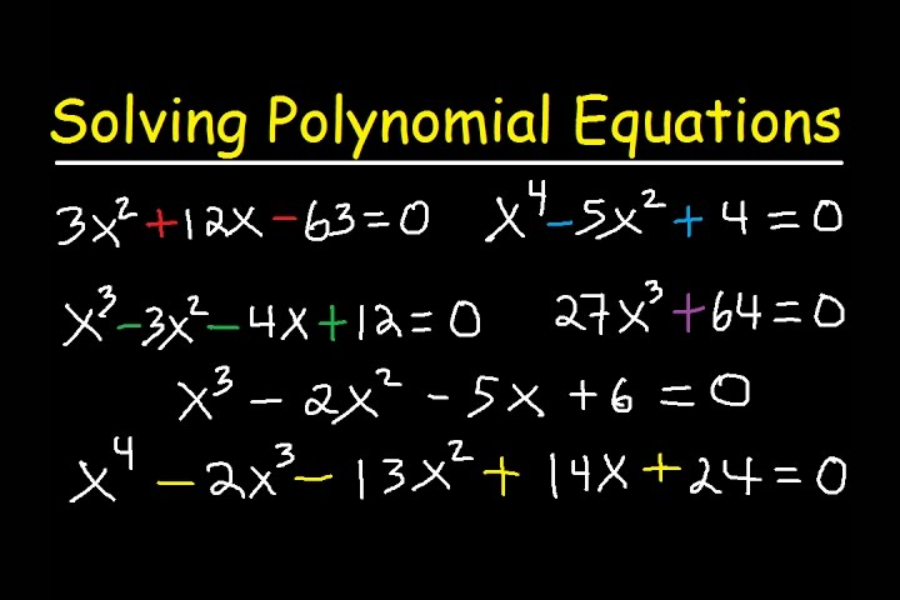A Beginner’s Guide to Solving Polynomial Equations with BF FDG and SF
Polynomial equations are more than just a collection of numbers and variables; they are foundational elements of mathematics that can unlock complex problems across various fields. Whether you’re solving equations for school or exploring real-world applications, mastering polynomial equation solving techniques such as BF FDG (Brute Force, Factorization, and Division) and SF (Substitution and Factoring) can significantly broaden your problem-solving skills.
This guide is tailored for beginners who might feel overwhelmed by polynomial equations. Fear not! We will break down everything from basic operations to advanced techniques in an easy-to-understand manner. Are you ready to embark on this mathematical journey? Let’s dive in!
Understanding Polynomials
Polynomials are algebraic expressions made up of variables raised to whole number exponents and coefficients. They can range from simple linear forms like 2x+32x + 32x+3 to more complex equations such as 4×3–5×2+x–74x^3 – 5x^2 + x – 74×3–5×2+x–7.
Key components of a polynomial include terms, which are separated by plus or minus signs. Each term has a coefficient (the number in front) and a variable part.
The degree of a polynomial is crucial as it refers to the highest exponent present in any term. For instance, in 3×4+2×2–x3x^4 + 2x^2 – x3x4+2×2–x, the degree is four.
Polynomials play an essential role in various fields, including physics, finance, and engineering. Understanding their structure lays the groundwork for solving more advanced mathematical problems effectively.
Basic Operations on Polynomials
Mastering basic operations on polynomials is essential for solving polynomial equations efficiently.
Addition and Subtraction
To add or subtract polynomials, combine like terms. This means identifying terms with the same degree and simply adding or subtracting their coefficients. For example, 3×2+5x23x^2 + 5x^23×2+5×2 results in 8x28x^28×2.
Multiplication
Multiplication requires a distributive approach. Distribute each term in the first polynomial to every term in the second. For instance, multiplying (x+1)(x+2)(x + 1)(x + 2)(x+1)(x+2) results in x2+3x+2x^2 + 3x + 2×2+3x+2.
Division
Division can be more complex but follows principles similar to long division with numbers. Synthetic division is a handy shortcut for dividing by linear factors.
These foundational operations form the backbone of more advanced techniques in polynomial equation solving, significantly enhancing your problem-solving toolkit.
Solving Linear Equations with One Variable
Solving linear equations with one variable is a fundamental skill in algebra. These equations typically take the form ax+b=0ax + b = 0ax+b=0, where aaa and bbb are constants, and xxx is the variable we want to find.
Steps to Solve
- Isolate xxx: Move all terms involving xxx to one side of the equation and shift the constant term to the opposite side.
- Example: For the equation 2x+4=02x + 4 = 02x+4=0, subtract 4 from both sides to get 2x=−42x = -42x=−4. Next, divide by 2 to solve for xxx.
Practice is key here. The more problems you tackle, the easier it becomes to recognize patterns and develop strategies for quicker solutions. Remember that every equation has a unique solution or no solution at all!
Factoring Polynomials
Factoring polynomials is a vital skill in solving polynomial equations. It involves breaking down complex expressions into simpler components that can be multiplied together to recreate the original polynomial.
Steps to Factor
- Identify Common Factors: Look for common factors among the terms and factor out the greatest common factor (GCF).
- Recognize Patterns: Familiarize yourself with patterns like the difference of squares or perfect square trinomials.
- Quadratics: For quadratic polynomials, find two numbers that multiply to the constant term while adding to the coefficient of xxx.
Practice helps in recognizing these patterns and improving your speed in factoring polynomials effectively!
Solving Quadratic Equations
Quadratic equations may seem intimidating initially, but they offer various methods to find solutions. They are typically presented in standard form as ax2+bx+c=0ax^2 + bx + c = 0ax2+bx+c=0.
Methods of Solution
- Factoring: If the equation can be factored into a product of two binomials, it simplifies solving significantly. Set each factor to zero and solve for xxx.
- Completing the Square: Rearranging the equation into a perfect square trinomial can make it easier to isolate xxx.
- Quadratic Formula: The reliable quadratic formula, x=−b±b2–4ac2ax = \frac{-b \pm \sqrt{b^2 – 4ac}}{2a}x=2a−b±b2–4ac, works universally for all quadratic equations.
Understanding these methods allows you to tackle polynomial equations with confidence.
Using the Quadratic Formula
The quadratic formula is a powerful tool for solving equations of the form ax2+bx+c=0ax^2 + bx + c = 0ax2+bx+c=0. This elegant equation, x=−b±b2–4ac2ax = \frac{-b \pm \sqrt{b^2 – 4ac}}{2a}x=2a−b±b2–4ac, allows for quick solutions.
Steps to Use the Quadratic Formula
- Identify Coefficients: Identify aaa, bbb, and ccc.
- Plug Values into the Formula: Insert the coefficients into the formula carefully. The discriminant (b2–4ac)(b^2 – 4ac)(b2–4ac) is crucial in determining the nature of the roots—real or complex.
- Positive Discriminant: Two distinct real roots.
- Zero Discriminant: One double root.
- Negative Discriminant: Complex roots.
This method is invaluable as it works across all quadratic equations without needing specific factoring skills.
Advanced Techniques for Solving Polynomial Equations
As you advance, various techniques can enhance your understanding and application of polynomial equations.
- Synthetic Division: This streamlined process simplifies polynomial division.
- Rational Root Theorem: Helps identify potential rational roots for quicker testing.
- Numerical Methods: For higher-degree polynomials, methods like Newton-Raphson provide approximate solutions when algebraic methods become cumbersome.
- Graphing Tools: Using graphing calculators or software to visualize polynomial behavior can reveal intersections with axes, indicating potential solutions.
- Advanced Factorization Techniques: Learning advanced factorization techniques can simplify complex expressions into manageable parts, aiding in both analytical and graphical problem-solving.
Embracing these strategies broadens your toolkit for tackling even the most challenging polynomial problems with confidence.
Real-World Applications of Polynomial Equations
Polynomial equations are not merely theoretical constructs; they have numerous practical applications in everyday life.
- Engineering: Engineers use polynomials to model structures, ensuring stability and safety in designs like bridges and buildings.
- Finance: Polynomial equations help calculate interest rates and investment growth over time, assisting financial analysts in making informed decisions.
- Computer Graphics: In computer graphics, polynomials are essential for rendering curves and surfaces, enabling programmers to create realistic animations and visual effects.
- Biology: Researchers use polynomial models to analyze population growth or disease spread, making predictions invaluable across multiple fields.
These diverse applications demonstrate how polynomial equation solving with BF FDG and SF techniques transcends classrooms, influencing critical aspects of our world daily.
Tips and Tricks for Success in Polynomial Equation Solving
- Understand the Basics: Familiarize yourself with terminology such as degree, coefficients, and roots. This foundational knowledge is empowering.
- Practice Consistently: The more equations you solve, the better you’ll understand different methods. Use varied resources for practice.
- Draw Graphs: Visualizing polynomials can clarify their behavior and help identify potential solutions.
- Stay Organized: Clearly write each step to avoid confusion. A tidy approach minimizes mistakes.
- Collaborate: Join study groups or discuss challenges with peers. New perspectives can enhance your problem-solving skills.
Conclusion
As you delve into polynomial equation solving with BF FDG and SF techniques, building a solid foundation is essential. Understanding the nature of polynomials sets the stage for more complex concepts. By mastering basic operations and linear equations, you position yourself for success in tackling quadratic equations.
Factoring polynomials opens new avenues for solutions, while the quadratic formula further simplifies the process. For those ready to tackle advanced techniques, numerous strategies await exploration.
The real-world applications of polynomial equations showcase their importance across various fields. Whether analyzing data trends or optimizing processes, these mathematical tools are invaluable.
As you embark on your journey through polynomial equation solving, keep these tips handy. With consistent practice and a willingness to learn, polynomial equation solving can become an approachable and rewarding endeavor. Embrace each challenge as an opportunity to enhance your mathematical skills!






